Australian Alcohol Consumption and Health Promotion Strategies Report
VerifiedAdded on 2022/11/07
|11
|2945
|436
Report
AI Summary
This report provides an overview of alcohol consumption in Australia, highlighting it as a major public health concern due to the associated harms and misuse. It examines various interventions implemented to reduce alcohol consumption, including both individual-level strategies like educational programs and population-level approaches such as taxation and advertising regulations. The report contrasts individual change interventions, which target at-risk individuals, with population-level interventions that aim to affect the entire community. It discusses the effectiveness of different strategies, such as brief interventions, mass media campaigns, and regulations on alcohol availability, while also acknowledging the political and social challenges in implementing these interventions. The report concludes by emphasizing effective interventions that address the wellbeing and welfare sector and have a positive influence on several health domains.
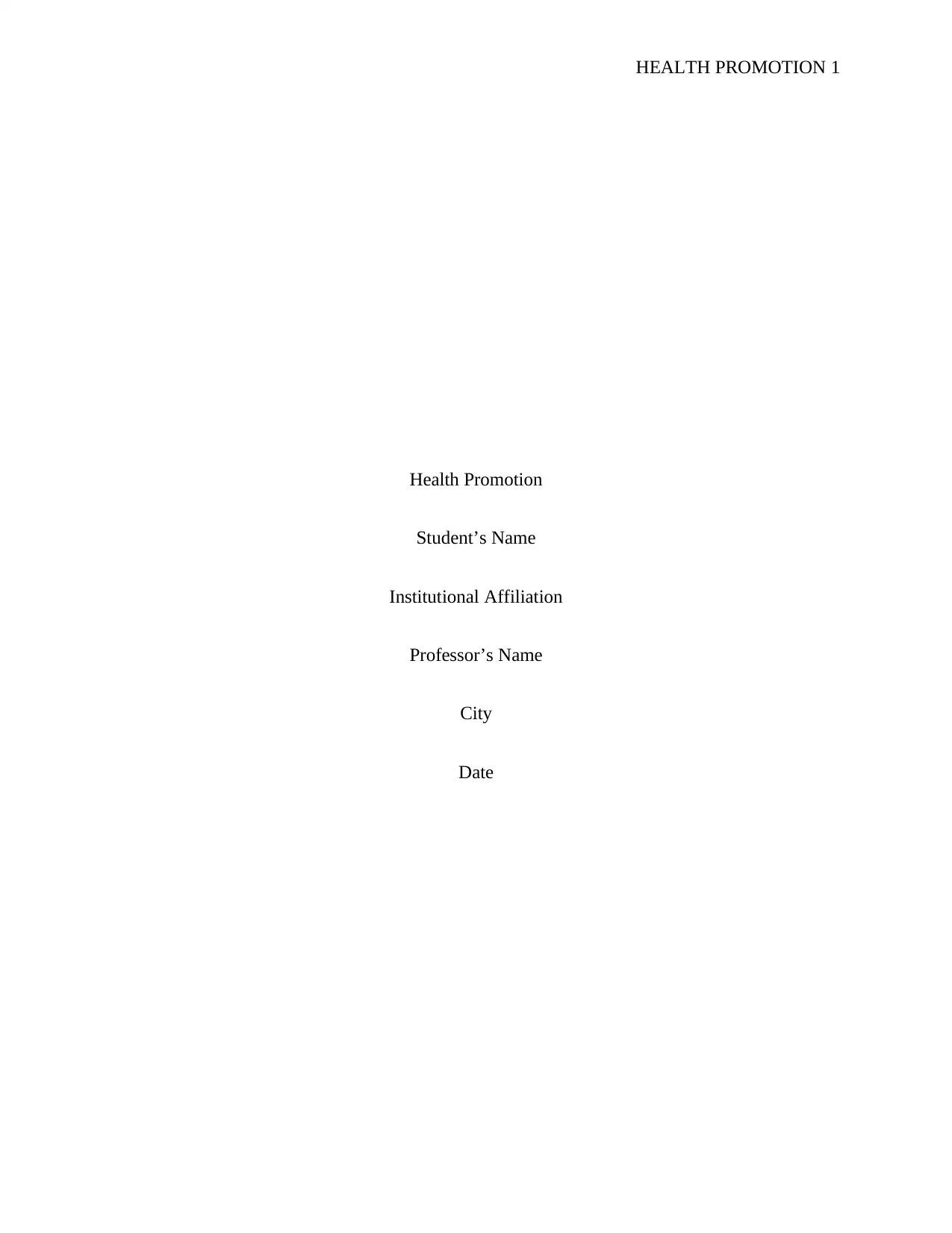
HEALTH PROMOTION 1
Health Promotion
Student’s Name
Institutional Affiliation
Professor’s Name
City
Date
Health Promotion
Student’s Name
Institutional Affiliation
Professor’s Name
City
Date
Paraphrase This Document
Need a fresh take? Get an instant paraphrase of this document with our AI Paraphraser
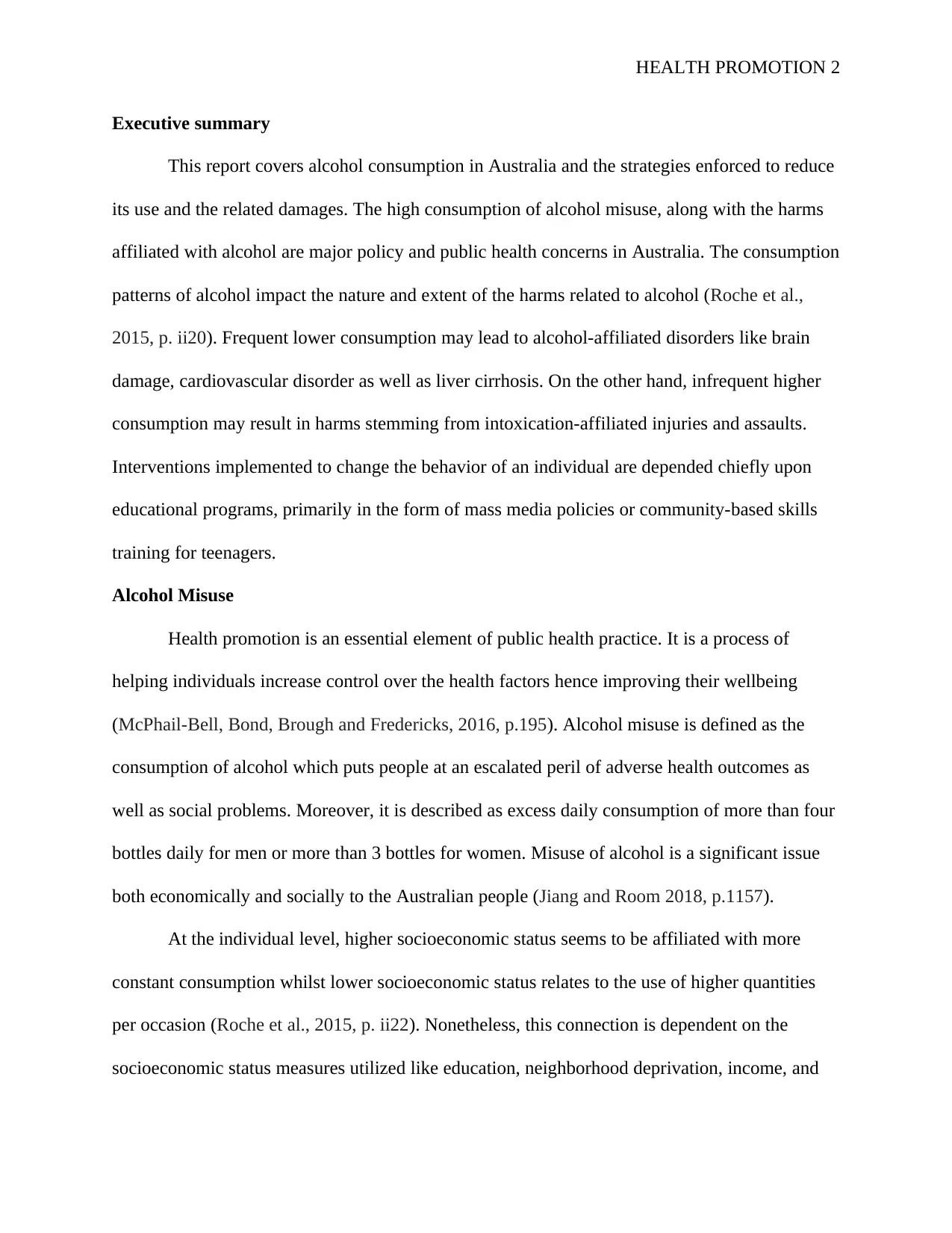
HEALTH PROMOTION 2
Executive summary
This report covers alcohol consumption in Australia and the strategies enforced to reduce
its use and the related damages. The high consumption of alcohol misuse, along with the harms
affiliated with alcohol are major policy and public health concerns in Australia. The consumption
patterns of alcohol impact the nature and extent of the harms related to alcohol (Roche et al.,
2015, p. ii20). Frequent lower consumption may lead to alcohol-affiliated disorders like brain
damage, cardiovascular disorder as well as liver cirrhosis. On the other hand, infrequent higher
consumption may result in harms stemming from intoxication-affiliated injuries and assaults.
Interventions implemented to change the behavior of an individual are depended chiefly upon
educational programs, primarily in the form of mass media policies or community-based skills
training for teenagers.
Alcohol Misuse
Health promotion is an essential element of public health practice. It is a process of
helping individuals increase control over the health factors hence improving their wellbeing
(McPhail-Bell, Bond, Brough and Fredericks, 2016, p.195). Alcohol misuse is defined as the
consumption of alcohol which puts people at an escalated peril of adverse health outcomes as
well as social problems. Moreover, it is described as excess daily consumption of more than four
bottles daily for men or more than 3 bottles for women. Misuse of alcohol is a significant issue
both economically and socially to the Australian people (Jiang and Room 2018, p.1157).
At the individual level, higher socioeconomic status seems to be affiliated with more
constant consumption whilst lower socioeconomic status relates to the use of higher quantities
per occasion (Roche et al., 2015, p. ii22). Nonetheless, this connection is dependent on the
socioeconomic status measures utilized like education, neighborhood deprivation, income, and
Executive summary
This report covers alcohol consumption in Australia and the strategies enforced to reduce
its use and the related damages. The high consumption of alcohol misuse, along with the harms
affiliated with alcohol are major policy and public health concerns in Australia. The consumption
patterns of alcohol impact the nature and extent of the harms related to alcohol (Roche et al.,
2015, p. ii20). Frequent lower consumption may lead to alcohol-affiliated disorders like brain
damage, cardiovascular disorder as well as liver cirrhosis. On the other hand, infrequent higher
consumption may result in harms stemming from intoxication-affiliated injuries and assaults.
Interventions implemented to change the behavior of an individual are depended chiefly upon
educational programs, primarily in the form of mass media policies or community-based skills
training for teenagers.
Alcohol Misuse
Health promotion is an essential element of public health practice. It is a process of
helping individuals increase control over the health factors hence improving their wellbeing
(McPhail-Bell, Bond, Brough and Fredericks, 2016, p.195). Alcohol misuse is defined as the
consumption of alcohol which puts people at an escalated peril of adverse health outcomes as
well as social problems. Moreover, it is described as excess daily consumption of more than four
bottles daily for men or more than 3 bottles for women. Misuse of alcohol is a significant issue
both economically and socially to the Australian people (Jiang and Room 2018, p.1157).
At the individual level, higher socioeconomic status seems to be affiliated with more
constant consumption whilst lower socioeconomic status relates to the use of higher quantities
per occasion (Roche et al., 2015, p. ii22). Nonetheless, this connection is dependent on the
socioeconomic status measures utilized like education, neighborhood deprivation, income, and
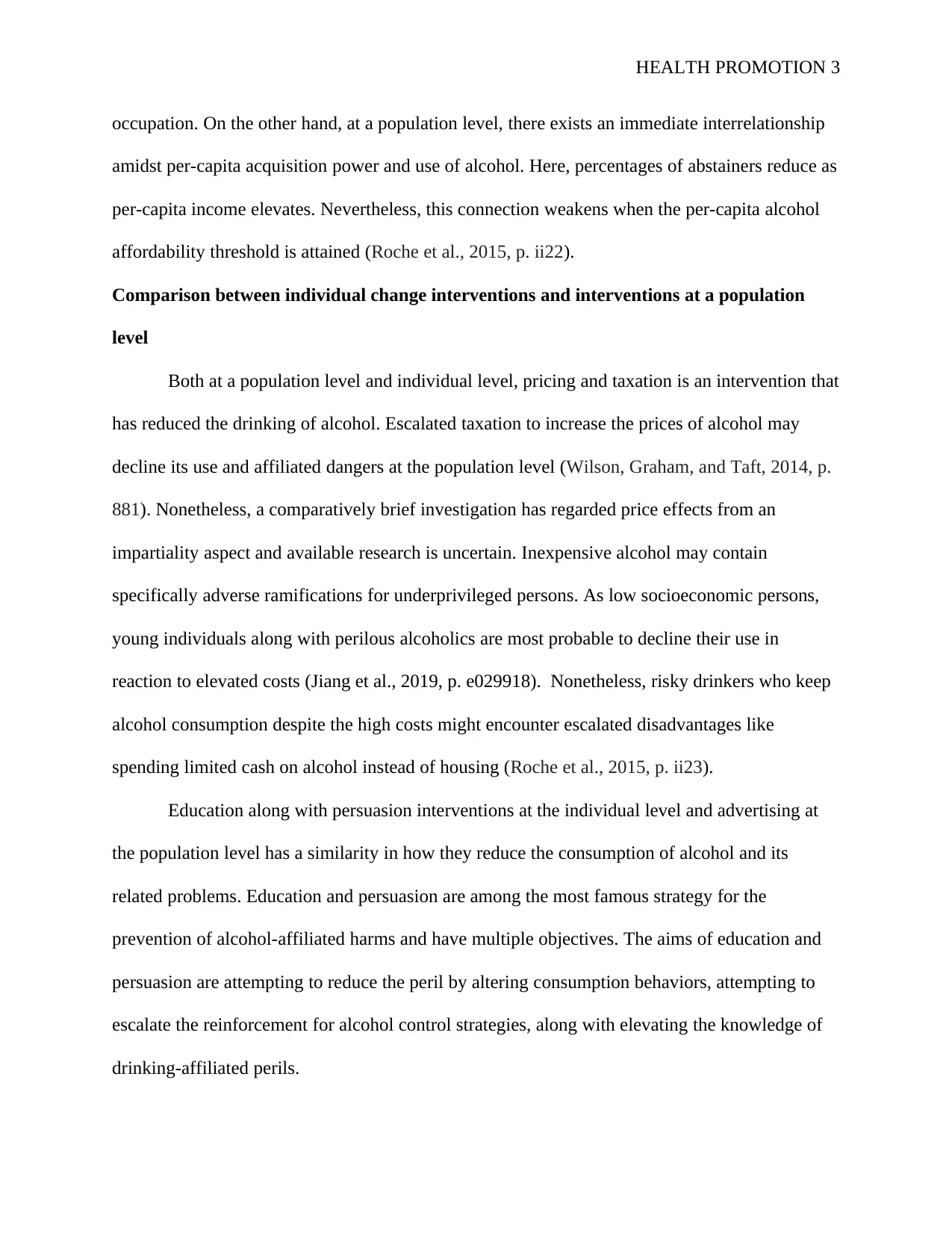
HEALTH PROMOTION 3
occupation. On the other hand, at a population level, there exists an immediate interrelationship
amidst per-capita acquisition power and use of alcohol. Here, percentages of abstainers reduce as
per-capita income elevates. Nevertheless, this connection weakens when the per-capita alcohol
affordability threshold is attained (Roche et al., 2015, p. ii22).
Comparison between individual change interventions and interventions at a population
level
Both at a population level and individual level, pricing and taxation is an intervention that
has reduced the drinking of alcohol. Escalated taxation to increase the prices of alcohol may
decline its use and affiliated dangers at the population level (Wilson, Graham, and Taft, 2014, p.
881). Nonetheless, a comparatively brief investigation has regarded price effects from an
impartiality aspect and available research is uncertain. Inexpensive alcohol may contain
specifically adverse ramifications for underprivileged persons. As low socioeconomic persons,
young individuals along with perilous alcoholics are most probable to decline their use in
reaction to elevated costs (Jiang et al., 2019, p. e029918). Nonetheless, risky drinkers who keep
alcohol consumption despite the high costs might encounter escalated disadvantages like
spending limited cash on alcohol instead of housing (Roche et al., 2015, p. ii23).
Education along with persuasion interventions at the individual level and advertising at
the population level has a similarity in how they reduce the consumption of alcohol and its
related problems. Education and persuasion are among the most famous strategy for the
prevention of alcohol-affiliated harms and have multiple objectives. The aims of education and
persuasion are attempting to reduce the peril by altering consumption behaviors, attempting to
escalate the reinforcement for alcohol control strategies, along with elevating the knowledge of
drinking-affiliated perils.
occupation. On the other hand, at a population level, there exists an immediate interrelationship
amidst per-capita acquisition power and use of alcohol. Here, percentages of abstainers reduce as
per-capita income elevates. Nevertheless, this connection weakens when the per-capita alcohol
affordability threshold is attained (Roche et al., 2015, p. ii22).
Comparison between individual change interventions and interventions at a population
level
Both at a population level and individual level, pricing and taxation is an intervention that
has reduced the drinking of alcohol. Escalated taxation to increase the prices of alcohol may
decline its use and affiliated dangers at the population level (Wilson, Graham, and Taft, 2014, p.
881). Nonetheless, a comparatively brief investigation has regarded price effects from an
impartiality aspect and available research is uncertain. Inexpensive alcohol may contain
specifically adverse ramifications for underprivileged persons. As low socioeconomic persons,
young individuals along with perilous alcoholics are most probable to decline their use in
reaction to elevated costs (Jiang et al., 2019, p. e029918). Nonetheless, risky drinkers who keep
alcohol consumption despite the high costs might encounter escalated disadvantages like
spending limited cash on alcohol instead of housing (Roche et al., 2015, p. ii23).
Education along with persuasion interventions at the individual level and advertising at
the population level has a similarity in how they reduce the consumption of alcohol and its
related problems. Education and persuasion are among the most famous strategy for the
prevention of alcohol-affiliated harms and have multiple objectives. The aims of education and
persuasion are attempting to reduce the peril by altering consumption behaviors, attempting to
escalate the reinforcement for alcohol control strategies, along with elevating the knowledge of
drinking-affiliated perils.
⊘ This is a preview!⊘
Do you want full access?
Subscribe today to unlock all pages.

Trusted by 1+ million students worldwide
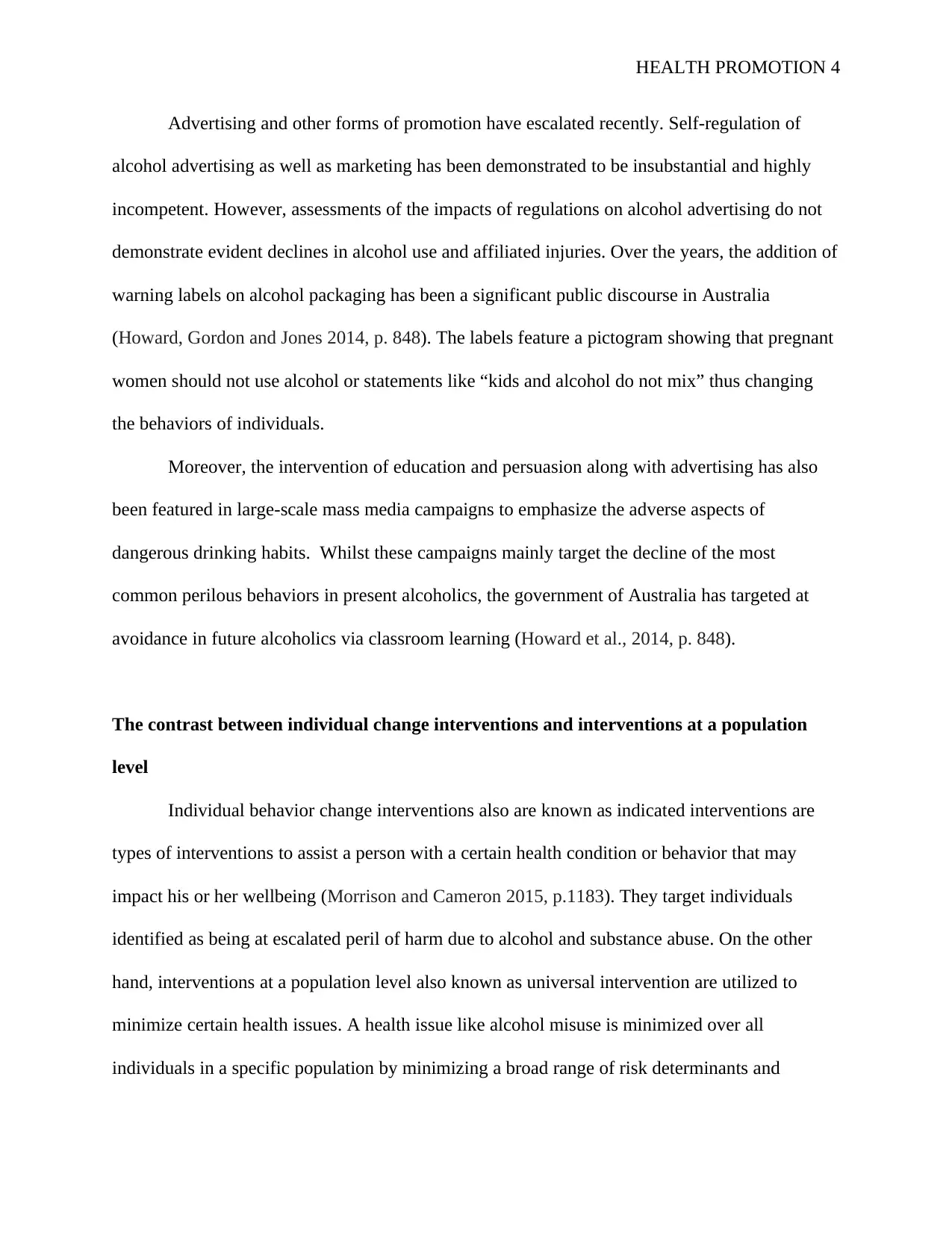
HEALTH PROMOTION 4
Advertising and other forms of promotion have escalated recently. Self-regulation of
alcohol advertising as well as marketing has been demonstrated to be insubstantial and highly
incompetent. However, assessments of the impacts of regulations on alcohol advertising do not
demonstrate evident declines in alcohol use and affiliated injuries. Over the years, the addition of
warning labels on alcohol packaging has been a significant public discourse in Australia
(Howard, Gordon and Jones 2014, p. 848). The labels feature a pictogram showing that pregnant
women should not use alcohol or statements like “kids and alcohol do not mix” thus changing
the behaviors of individuals.
Moreover, the intervention of education and persuasion along with advertising has also
been featured in large-scale mass media campaigns to emphasize the adverse aspects of
dangerous drinking habits. Whilst these campaigns mainly target the decline of the most
common perilous behaviors in present alcoholics, the government of Australia has targeted at
avoidance in future alcoholics via classroom learning (Howard et al., 2014, p. 848).
The contrast between individual change interventions and interventions at a population
level
Individual behavior change interventions also are known as indicated interventions are
types of interventions to assist a person with a certain health condition or behavior that may
impact his or her wellbeing (Morrison and Cameron 2015, p.1183). They target individuals
identified as being at escalated peril of harm due to alcohol and substance abuse. On the other
hand, interventions at a population level also known as universal intervention are utilized to
minimize certain health issues. A health issue like alcohol misuse is minimized over all
individuals in a specific population by minimizing a broad range of risk determinants and
Advertising and other forms of promotion have escalated recently. Self-regulation of
alcohol advertising as well as marketing has been demonstrated to be insubstantial and highly
incompetent. However, assessments of the impacts of regulations on alcohol advertising do not
demonstrate evident declines in alcohol use and affiliated injuries. Over the years, the addition of
warning labels on alcohol packaging has been a significant public discourse in Australia
(Howard, Gordon and Jones 2014, p. 848). The labels feature a pictogram showing that pregnant
women should not use alcohol or statements like “kids and alcohol do not mix” thus changing
the behaviors of individuals.
Moreover, the intervention of education and persuasion along with advertising has also
been featured in large-scale mass media campaigns to emphasize the adverse aspects of
dangerous drinking habits. Whilst these campaigns mainly target the decline of the most
common perilous behaviors in present alcoholics, the government of Australia has targeted at
avoidance in future alcoholics via classroom learning (Howard et al., 2014, p. 848).
The contrast between individual change interventions and interventions at a population
level
Individual behavior change interventions also are known as indicated interventions are
types of interventions to assist a person with a certain health condition or behavior that may
impact his or her wellbeing (Morrison and Cameron 2015, p.1183). They target individuals
identified as being at escalated peril of harm due to alcohol and substance abuse. On the other
hand, interventions at a population level also known as universal intervention are utilized to
minimize certain health issues. A health issue like alcohol misuse is minimized over all
individuals in a specific population by minimizing a broad range of risk determinants and
Paraphrase This Document
Need a fresh take? Get an instant paraphrase of this document with our AI Paraphraser
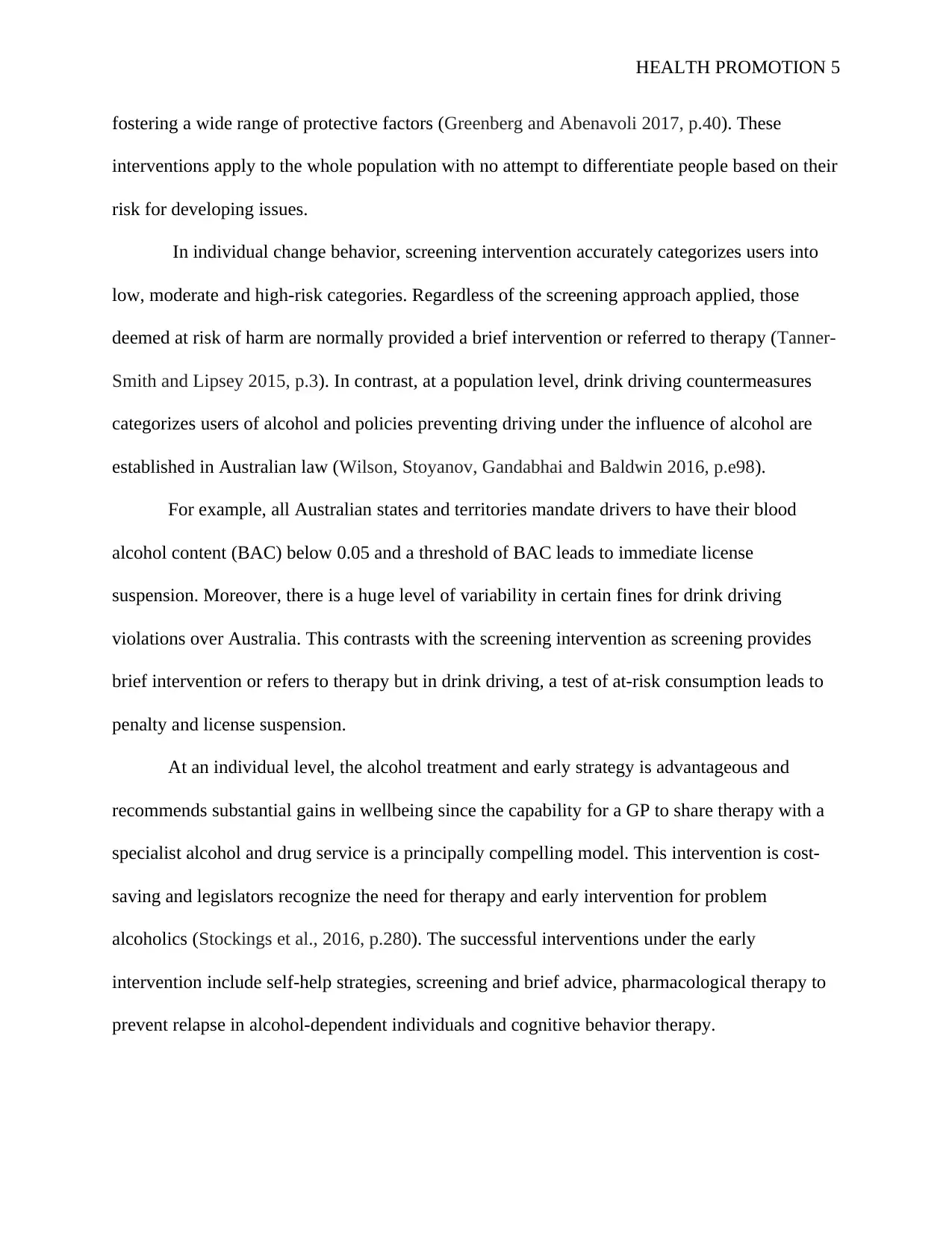
HEALTH PROMOTION 5
fostering a wide range of protective factors (Greenberg and Abenavoli 2017, p.40). These
interventions apply to the whole population with no attempt to differentiate people based on their
risk for developing issues.
In individual change behavior, screening intervention accurately categorizes users into
low, moderate and high-risk categories. Regardless of the screening approach applied, those
deemed at risk of harm are normally provided a brief intervention or referred to therapy (Tanner-
Smith and Lipsey 2015, p.3). In contrast, at a population level, drink driving countermeasures
categorizes users of alcohol and policies preventing driving under the influence of alcohol are
established in Australian law (Wilson, Stoyanov, Gandabhai and Baldwin 2016, p.e98).
For example, all Australian states and territories mandate drivers to have their blood
alcohol content (BAC) below 0.05 and a threshold of BAC leads to immediate license
suspension. Moreover, there is a huge level of variability in certain fines for drink driving
violations over Australia. This contrasts with the screening intervention as screening provides
brief intervention or refers to therapy but in drink driving, a test of at-risk consumption leads to
penalty and license suspension.
At an individual level, the alcohol treatment and early strategy is advantageous and
recommends substantial gains in wellbeing since the capability for a GP to share therapy with a
specialist alcohol and drug service is a principally compelling model. This intervention is cost-
saving and legislators recognize the need for therapy and early intervention for problem
alcoholics (Stockings et al., 2016, p.280). The successful interventions under the early
intervention include self-help strategies, screening and brief advice, pharmacological therapy to
prevent relapse in alcohol-dependent individuals and cognitive behavior therapy.
fostering a wide range of protective factors (Greenberg and Abenavoli 2017, p.40). These
interventions apply to the whole population with no attempt to differentiate people based on their
risk for developing issues.
In individual change behavior, screening intervention accurately categorizes users into
low, moderate and high-risk categories. Regardless of the screening approach applied, those
deemed at risk of harm are normally provided a brief intervention or referred to therapy (Tanner-
Smith and Lipsey 2015, p.3). In contrast, at a population level, drink driving countermeasures
categorizes users of alcohol and policies preventing driving under the influence of alcohol are
established in Australian law (Wilson, Stoyanov, Gandabhai and Baldwin 2016, p.e98).
For example, all Australian states and territories mandate drivers to have their blood
alcohol content (BAC) below 0.05 and a threshold of BAC leads to immediate license
suspension. Moreover, there is a huge level of variability in certain fines for drink driving
violations over Australia. This contrasts with the screening intervention as screening provides
brief intervention or refers to therapy but in drink driving, a test of at-risk consumption leads to
penalty and license suspension.
At an individual level, the alcohol treatment and early strategy is advantageous and
recommends substantial gains in wellbeing since the capability for a GP to share therapy with a
specialist alcohol and drug service is a principally compelling model. This intervention is cost-
saving and legislators recognize the need for therapy and early intervention for problem
alcoholics (Stockings et al., 2016, p.280). The successful interventions under the early
intervention include self-help strategies, screening and brief advice, pharmacological therapy to
prevent relapse in alcohol-dependent individuals and cognitive behavior therapy.
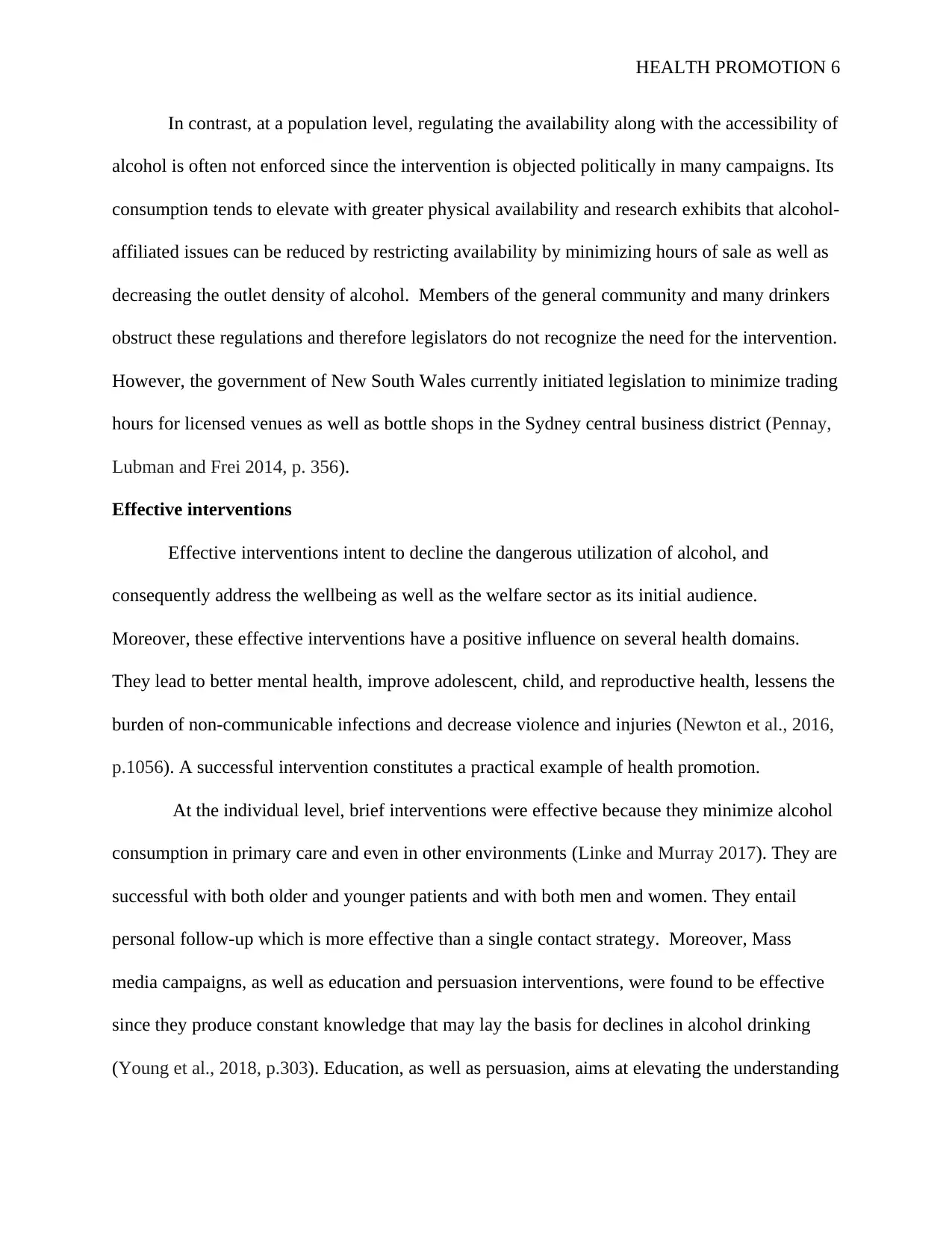
HEALTH PROMOTION 6
In contrast, at a population level, regulating the availability along with the accessibility of
alcohol is often not enforced since the intervention is objected politically in many campaigns. Its
consumption tends to elevate with greater physical availability and research exhibits that alcohol-
affiliated issues can be reduced by restricting availability by minimizing hours of sale as well as
decreasing the outlet density of alcohol. Members of the general community and many drinkers
obstruct these regulations and therefore legislators do not recognize the need for the intervention.
However, the government of New South Wales currently initiated legislation to minimize trading
hours for licensed venues as well as bottle shops in the Sydney central business district (Pennay,
Lubman and Frei 2014, p. 356).
Effective interventions
Effective interventions intent to decline the dangerous utilization of alcohol, and
consequently address the wellbeing as well as the welfare sector as its initial audience.
Moreover, these effective interventions have a positive influence on several health domains.
They lead to better mental health, improve adolescent, child, and reproductive health, lessens the
burden of non-communicable infections and decrease violence and injuries (Newton et al., 2016,
p.1056). A successful intervention constitutes a practical example of health promotion.
At the individual level, brief interventions were effective because they minimize alcohol
consumption in primary care and even in other environments (Linke and Murray 2017). They are
successful with both older and younger patients and with both men and women. They entail
personal follow-up which is more effective than a single contact strategy. Moreover, Mass
media campaigns, as well as education and persuasion interventions, were found to be effective
since they produce constant knowledge that may lay the basis for declines in alcohol drinking
(Young et al., 2018, p.303). Education, as well as persuasion, aims at elevating the understanding
In contrast, at a population level, regulating the availability along with the accessibility of
alcohol is often not enforced since the intervention is objected politically in many campaigns. Its
consumption tends to elevate with greater physical availability and research exhibits that alcohol-
affiliated issues can be reduced by restricting availability by minimizing hours of sale as well as
decreasing the outlet density of alcohol. Members of the general community and many drinkers
obstruct these regulations and therefore legislators do not recognize the need for the intervention.
However, the government of New South Wales currently initiated legislation to minimize trading
hours for licensed venues as well as bottle shops in the Sydney central business district (Pennay,
Lubman and Frei 2014, p. 356).
Effective interventions
Effective interventions intent to decline the dangerous utilization of alcohol, and
consequently address the wellbeing as well as the welfare sector as its initial audience.
Moreover, these effective interventions have a positive influence on several health domains.
They lead to better mental health, improve adolescent, child, and reproductive health, lessens the
burden of non-communicable infections and decrease violence and injuries (Newton et al., 2016,
p.1056). A successful intervention constitutes a practical example of health promotion.
At the individual level, brief interventions were effective because they minimize alcohol
consumption in primary care and even in other environments (Linke and Murray 2017). They are
successful with both older and younger patients and with both men and women. They entail
personal follow-up which is more effective than a single contact strategy. Moreover, Mass
media campaigns, as well as education and persuasion interventions, were found to be effective
since they produce constant knowledge that may lay the basis for declines in alcohol drinking
(Young et al., 2018, p.303). Education, as well as persuasion, aims at elevating the understanding
⊘ This is a preview!⊘
Do you want full access?
Subscribe today to unlock all pages.

Trusted by 1+ million students worldwide
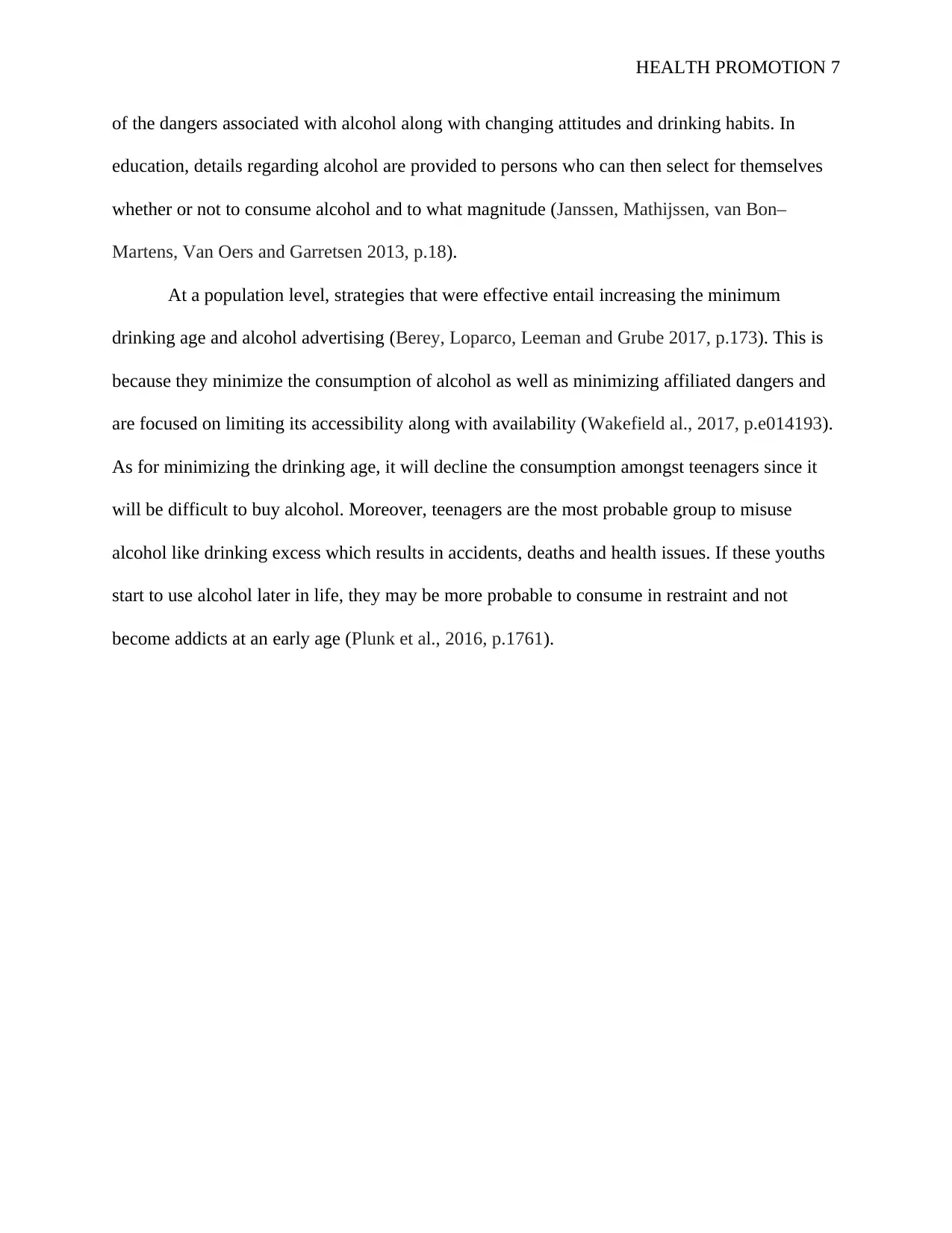
HEALTH PROMOTION 7
of the dangers associated with alcohol along with changing attitudes and drinking habits. In
education, details regarding alcohol are provided to persons who can then select for themselves
whether or not to consume alcohol and to what magnitude (Janssen, Mathijssen, van Bon–
Martens, Van Oers and Garretsen 2013, p.18).
At a population level, strategies that were effective entail increasing the minimum
drinking age and alcohol advertising (Berey, Loparco, Leeman and Grube 2017, p.173). This is
because they minimize the consumption of alcohol as well as minimizing affiliated dangers and
are focused on limiting its accessibility along with availability (Wakefield al., 2017, p.e014193).
As for minimizing the drinking age, it will decline the consumption amongst teenagers since it
will be difficult to buy alcohol. Moreover, teenagers are the most probable group to misuse
alcohol like drinking excess which results in accidents, deaths and health issues. If these youths
start to use alcohol later in life, they may be more probable to consume in restraint and not
become addicts at an early age (Plunk et al., 2016, p.1761).
of the dangers associated with alcohol along with changing attitudes and drinking habits. In
education, details regarding alcohol are provided to persons who can then select for themselves
whether or not to consume alcohol and to what magnitude (Janssen, Mathijssen, van Bon–
Martens, Van Oers and Garretsen 2013, p.18).
At a population level, strategies that were effective entail increasing the minimum
drinking age and alcohol advertising (Berey, Loparco, Leeman and Grube 2017, p.173). This is
because they minimize the consumption of alcohol as well as minimizing affiliated dangers and
are focused on limiting its accessibility along with availability (Wakefield al., 2017, p.e014193).
As for minimizing the drinking age, it will decline the consumption amongst teenagers since it
will be difficult to buy alcohol. Moreover, teenagers are the most probable group to misuse
alcohol like drinking excess which results in accidents, deaths and health issues. If these youths
start to use alcohol later in life, they may be more probable to consume in restraint and not
become addicts at an early age (Plunk et al., 2016, p.1761).
Paraphrase This Document
Need a fresh take? Get an instant paraphrase of this document with our AI Paraphraser
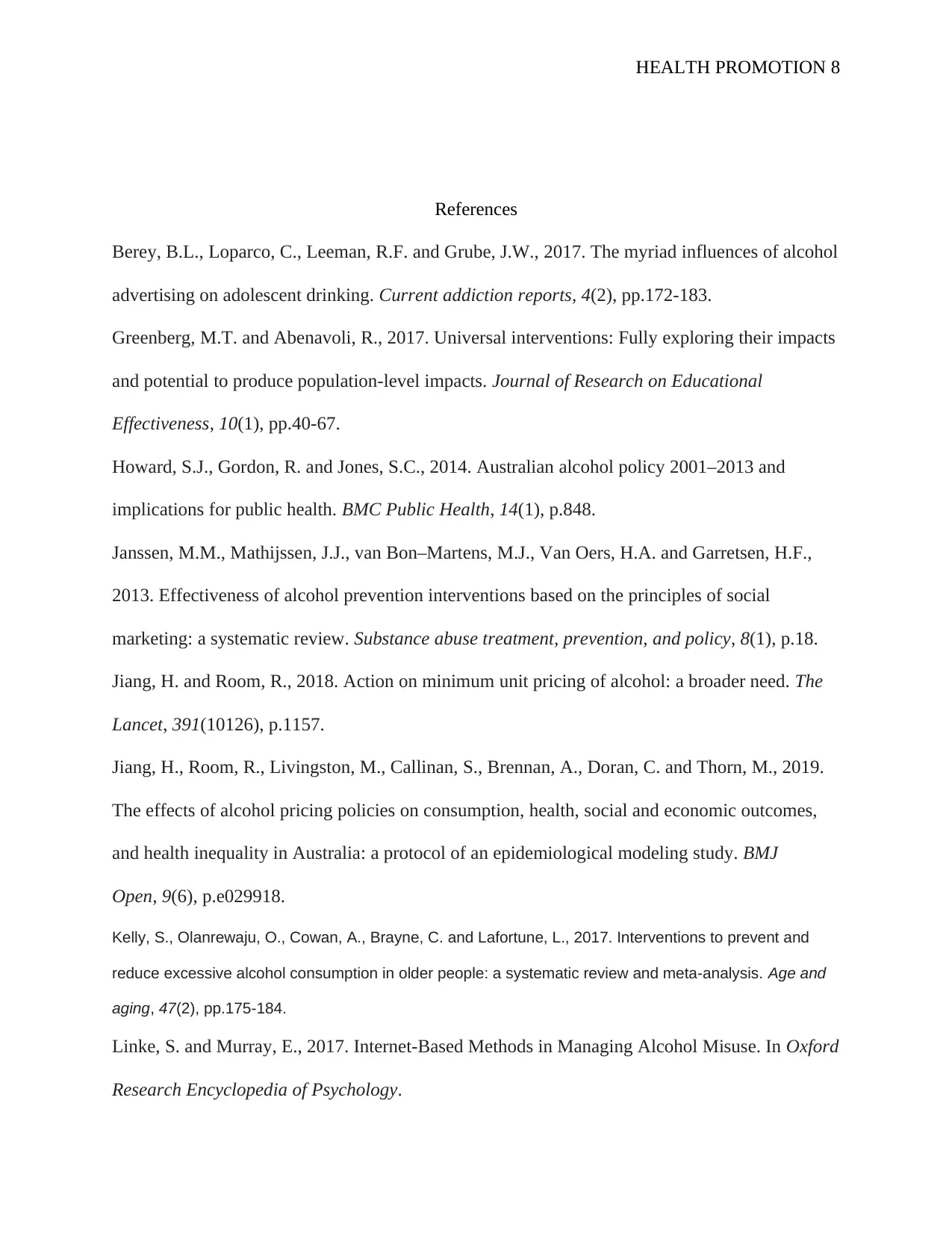
HEALTH PROMOTION 8
References
Berey, B.L., Loparco, C., Leeman, R.F. and Grube, J.W., 2017. The myriad influences of alcohol
advertising on adolescent drinking. Current addiction reports, 4(2), pp.172-183.
Greenberg, M.T. and Abenavoli, R., 2017. Universal interventions: Fully exploring their impacts
and potential to produce population-level impacts. Journal of Research on Educational
Effectiveness, 10(1), pp.40-67.
Howard, S.J., Gordon, R. and Jones, S.C., 2014. Australian alcohol policy 2001–2013 and
implications for public health. BMC Public Health, 14(1), p.848.
Janssen, M.M., Mathijssen, J.J., van Bon–Martens, M.J., Van Oers, H.A. and Garretsen, H.F.,
2013. Effectiveness of alcohol prevention interventions based on the principles of social
marketing: a systematic review. Substance abuse treatment, prevention, and policy, 8(1), p.18.
Jiang, H. and Room, R., 2018. Action on minimum unit pricing of alcohol: a broader need. The
Lancet, 391(10126), p.1157.
Jiang, H., Room, R., Livingston, M., Callinan, S., Brennan, A., Doran, C. and Thorn, M., 2019.
The effects of alcohol pricing policies on consumption, health, social and economic outcomes,
and health inequality in Australia: a protocol of an epidemiological modeling study. BMJ
Open, 9(6), p.e029918.
Kelly, S., Olanrewaju, O., Cowan, A., Brayne, C. and Lafortune, L., 2017. Interventions to prevent and
reduce excessive alcohol consumption in older people: a systematic review and meta-analysis. Age and
aging, 47(2), pp.175-184.
Linke, S. and Murray, E., 2017. Internet-Based Methods in Managing Alcohol Misuse. In Oxford
Research Encyclopedia of Psychology.
References
Berey, B.L., Loparco, C., Leeman, R.F. and Grube, J.W., 2017. The myriad influences of alcohol
advertising on adolescent drinking. Current addiction reports, 4(2), pp.172-183.
Greenberg, M.T. and Abenavoli, R., 2017. Universal interventions: Fully exploring their impacts
and potential to produce population-level impacts. Journal of Research on Educational
Effectiveness, 10(1), pp.40-67.
Howard, S.J., Gordon, R. and Jones, S.C., 2014. Australian alcohol policy 2001–2013 and
implications for public health. BMC Public Health, 14(1), p.848.
Janssen, M.M., Mathijssen, J.J., van Bon–Martens, M.J., Van Oers, H.A. and Garretsen, H.F.,
2013. Effectiveness of alcohol prevention interventions based on the principles of social
marketing: a systematic review. Substance abuse treatment, prevention, and policy, 8(1), p.18.
Jiang, H. and Room, R., 2018. Action on minimum unit pricing of alcohol: a broader need. The
Lancet, 391(10126), p.1157.
Jiang, H., Room, R., Livingston, M., Callinan, S., Brennan, A., Doran, C. and Thorn, M., 2019.
The effects of alcohol pricing policies on consumption, health, social and economic outcomes,
and health inequality in Australia: a protocol of an epidemiological modeling study. BMJ
Open, 9(6), p.e029918.
Kelly, S., Olanrewaju, O., Cowan, A., Brayne, C. and Lafortune, L., 2017. Interventions to prevent and
reduce excessive alcohol consumption in older people: a systematic review and meta-analysis. Age and
aging, 47(2), pp.175-184.
Linke, S. and Murray, E., 2017. Internet-Based Methods in Managing Alcohol Misuse. In Oxford
Research Encyclopedia of Psychology.
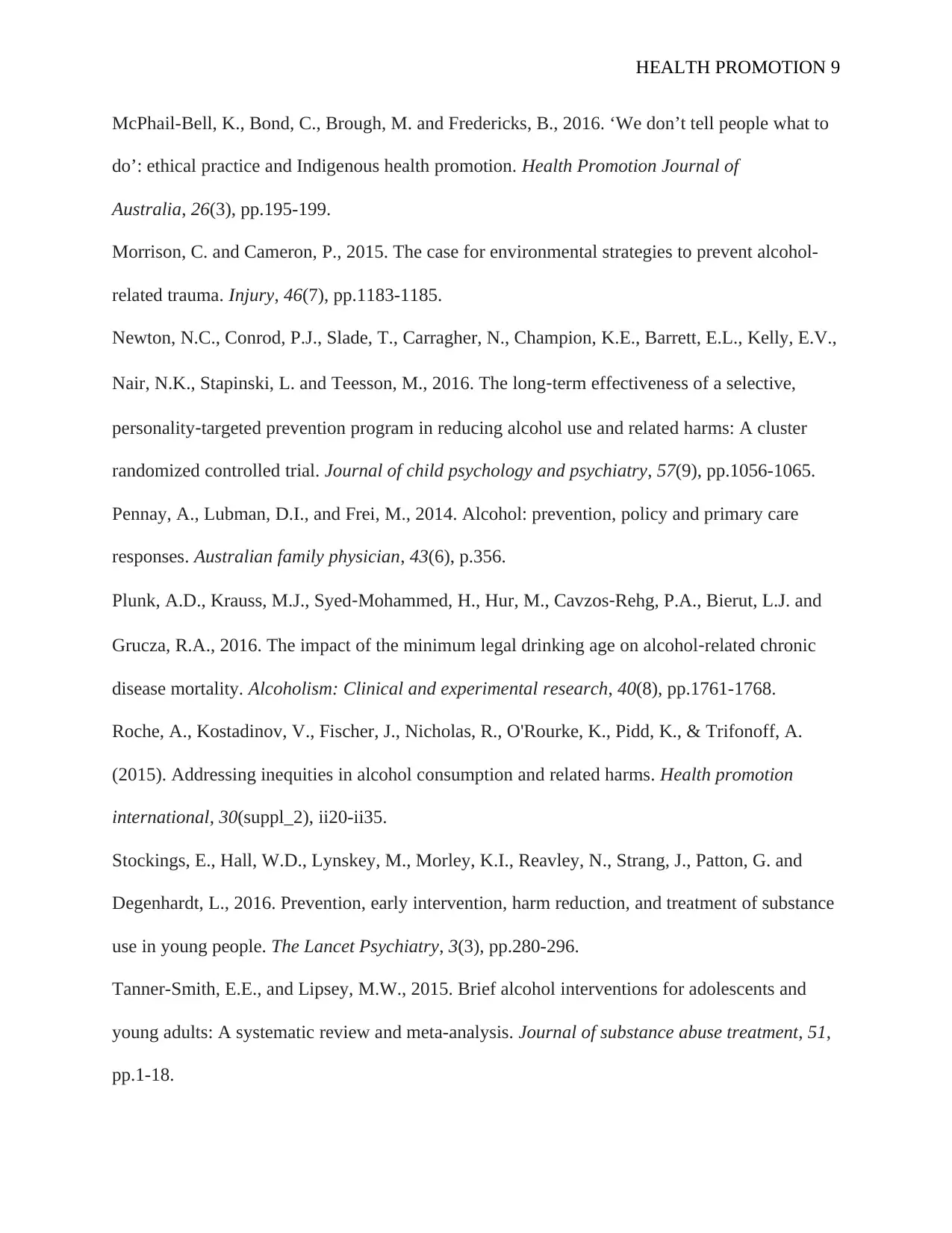
HEALTH PROMOTION 9
McPhail-Bell, K., Bond, C., Brough, M. and Fredericks, B., 2016. ‘We don’t tell people what to
do’: ethical practice and Indigenous health promotion. Health Promotion Journal of
Australia, 26(3), pp.195-199.
Morrison, C. and Cameron, P., 2015. The case for environmental strategies to prevent alcohol-
related trauma. Injury, 46(7), pp.1183-1185.
Newton, N.C., Conrod, P.J., Slade, T., Carragher, N., Champion, K.E., Barrett, E.L., Kelly, E.V.,
Nair, N.K., Stapinski, L. and Teesson, M., 2016. The long‐term effectiveness of a selective,
personality‐targeted prevention program in reducing alcohol use and related harms: A cluster
randomized controlled trial. Journal of child psychology and psychiatry, 57(9), pp.1056-1065.
Pennay, A., Lubman, D.I., and Frei, M., 2014. Alcohol: prevention, policy and primary care
responses. Australian family physician, 43(6), p.356.
Plunk, A.D., Krauss, M.J., Syed‐Mohammed, H., Hur, M., Cavzos‐Rehg, P.A., Bierut, L.J. and
Grucza, R.A., 2016. The impact of the minimum legal drinking age on alcohol‐related chronic
disease mortality. Alcoholism: Clinical and experimental research, 40(8), pp.1761-1768.
Roche, A., Kostadinov, V., Fischer, J., Nicholas, R., O'Rourke, K., Pidd, K., & Trifonoff, A.
(2015). Addressing inequities in alcohol consumption and related harms. Health promotion
international, 30(suppl_2), ii20-ii35.
Stockings, E., Hall, W.D., Lynskey, M., Morley, K.I., Reavley, N., Strang, J., Patton, G. and
Degenhardt, L., 2016. Prevention, early intervention, harm reduction, and treatment of substance
use in young people. The Lancet Psychiatry, 3(3), pp.280-296.
Tanner-Smith, E.E., and Lipsey, M.W., 2015. Brief alcohol interventions for adolescents and
young adults: A systematic review and meta-analysis. Journal of substance abuse treatment, 51,
pp.1-18.
McPhail-Bell, K., Bond, C., Brough, M. and Fredericks, B., 2016. ‘We don’t tell people what to
do’: ethical practice and Indigenous health promotion. Health Promotion Journal of
Australia, 26(3), pp.195-199.
Morrison, C. and Cameron, P., 2015. The case for environmental strategies to prevent alcohol-
related trauma. Injury, 46(7), pp.1183-1185.
Newton, N.C., Conrod, P.J., Slade, T., Carragher, N., Champion, K.E., Barrett, E.L., Kelly, E.V.,
Nair, N.K., Stapinski, L. and Teesson, M., 2016. The long‐term effectiveness of a selective,
personality‐targeted prevention program in reducing alcohol use and related harms: A cluster
randomized controlled trial. Journal of child psychology and psychiatry, 57(9), pp.1056-1065.
Pennay, A., Lubman, D.I., and Frei, M., 2014. Alcohol: prevention, policy and primary care
responses. Australian family physician, 43(6), p.356.
Plunk, A.D., Krauss, M.J., Syed‐Mohammed, H., Hur, M., Cavzos‐Rehg, P.A., Bierut, L.J. and
Grucza, R.A., 2016. The impact of the minimum legal drinking age on alcohol‐related chronic
disease mortality. Alcoholism: Clinical and experimental research, 40(8), pp.1761-1768.
Roche, A., Kostadinov, V., Fischer, J., Nicholas, R., O'Rourke, K., Pidd, K., & Trifonoff, A.
(2015). Addressing inequities in alcohol consumption and related harms. Health promotion
international, 30(suppl_2), ii20-ii35.
Stockings, E., Hall, W.D., Lynskey, M., Morley, K.I., Reavley, N., Strang, J., Patton, G. and
Degenhardt, L., 2016. Prevention, early intervention, harm reduction, and treatment of substance
use in young people. The Lancet Psychiatry, 3(3), pp.280-296.
Tanner-Smith, E.E., and Lipsey, M.W., 2015. Brief alcohol interventions for adolescents and
young adults: A systematic review and meta-analysis. Journal of substance abuse treatment, 51,
pp.1-18.
⊘ This is a preview!⊘
Do you want full access?
Subscribe today to unlock all pages.

Trusted by 1+ million students worldwide
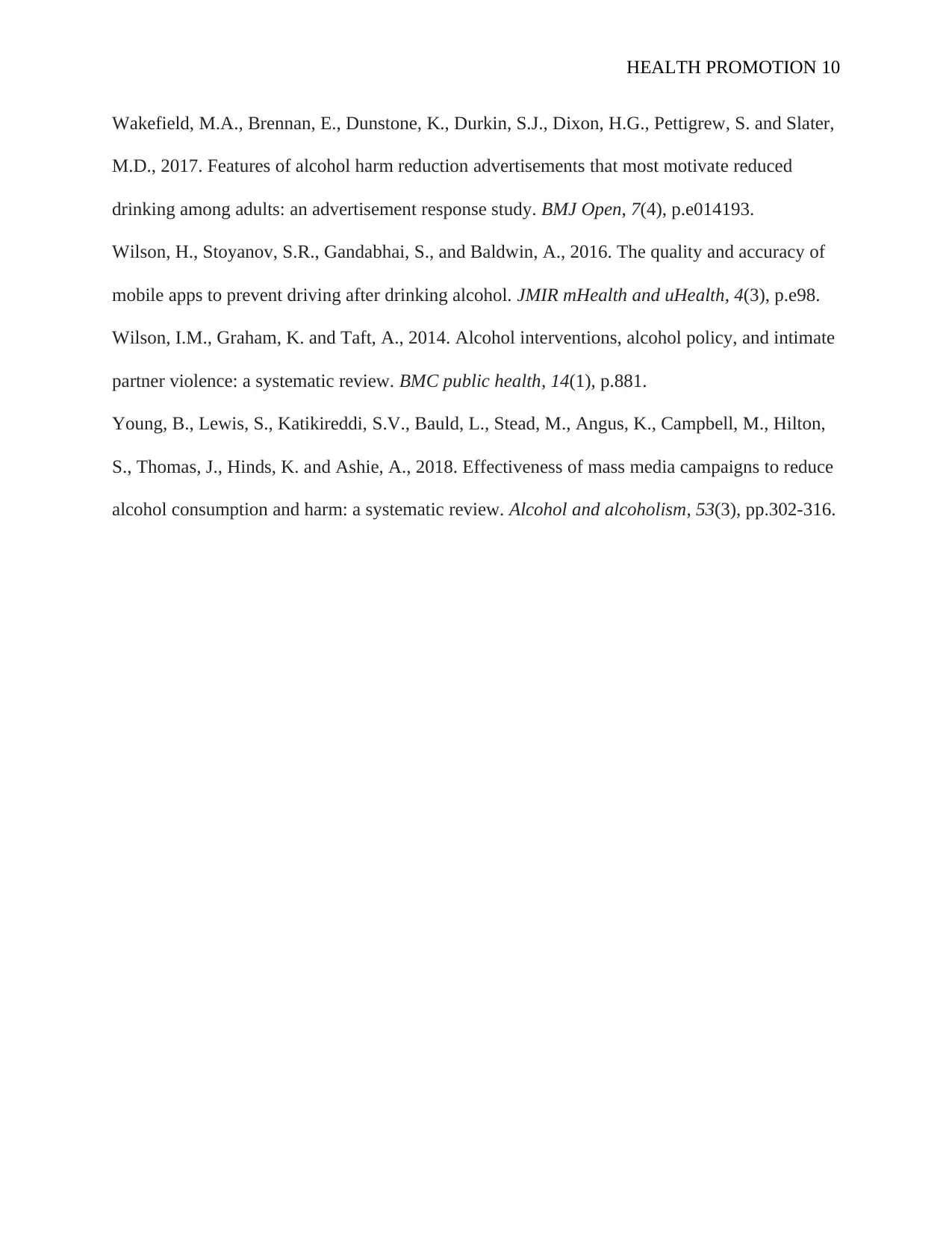
HEALTH PROMOTION 10
Wakefield, M.A., Brennan, E., Dunstone, K., Durkin, S.J., Dixon, H.G., Pettigrew, S. and Slater,
M.D., 2017. Features of alcohol harm reduction advertisements that most motivate reduced
drinking among adults: an advertisement response study. BMJ Open, 7(4), p.e014193.
Wilson, H., Stoyanov, S.R., Gandabhai, S., and Baldwin, A., 2016. The quality and accuracy of
mobile apps to prevent driving after drinking alcohol. JMIR mHealth and uHealth, 4(3), p.e98.
Wilson, I.M., Graham, K. and Taft, A., 2014. Alcohol interventions, alcohol policy, and intimate
partner violence: a systematic review. BMC public health, 14(1), p.881.
Young, B., Lewis, S., Katikireddi, S.V., Bauld, L., Stead, M., Angus, K., Campbell, M., Hilton,
S., Thomas, J., Hinds, K. and Ashie, A., 2018. Effectiveness of mass media campaigns to reduce
alcohol consumption and harm: a systematic review. Alcohol and alcoholism, 53(3), pp.302-316.
Wakefield, M.A., Brennan, E., Dunstone, K., Durkin, S.J., Dixon, H.G., Pettigrew, S. and Slater,
M.D., 2017. Features of alcohol harm reduction advertisements that most motivate reduced
drinking among adults: an advertisement response study. BMJ Open, 7(4), p.e014193.
Wilson, H., Stoyanov, S.R., Gandabhai, S., and Baldwin, A., 2016. The quality and accuracy of
mobile apps to prevent driving after drinking alcohol. JMIR mHealth and uHealth, 4(3), p.e98.
Wilson, I.M., Graham, K. and Taft, A., 2014. Alcohol interventions, alcohol policy, and intimate
partner violence: a systematic review. BMC public health, 14(1), p.881.
Young, B., Lewis, S., Katikireddi, S.V., Bauld, L., Stead, M., Angus, K., Campbell, M., Hilton,
S., Thomas, J., Hinds, K. and Ashie, A., 2018. Effectiveness of mass media campaigns to reduce
alcohol consumption and harm: a systematic review. Alcohol and alcoholism, 53(3), pp.302-316.
Paraphrase This Document
Need a fresh take? Get an instant paraphrase of this document with our AI Paraphraser
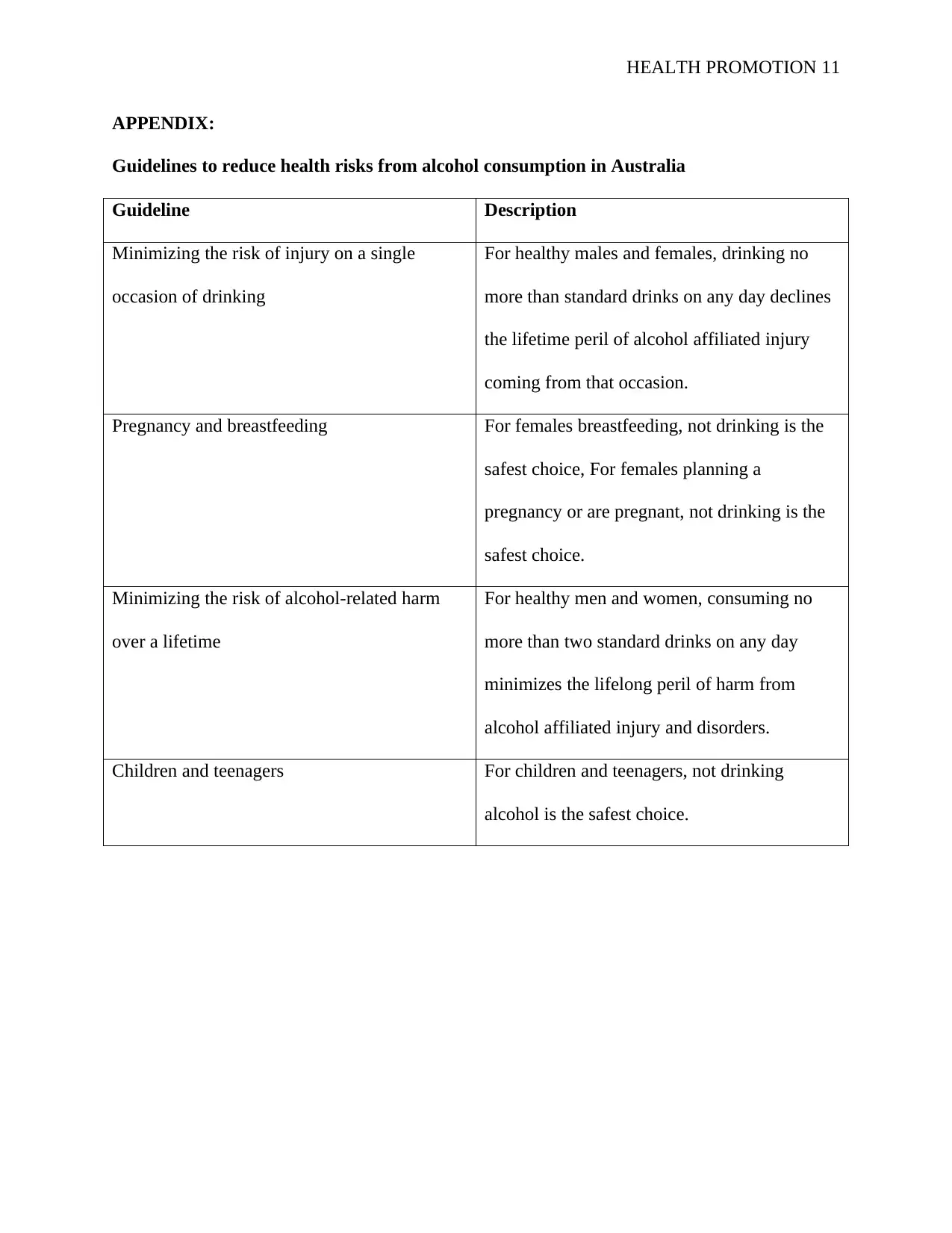
HEALTH PROMOTION 11
APPENDIX:
Guidelines to reduce health risks from alcohol consumption in Australia
Guideline Description
Minimizing the risk of injury on a single
occasion of drinking
For healthy males and females, drinking no
more than standard drinks on any day declines
the lifetime peril of alcohol affiliated injury
coming from that occasion.
Pregnancy and breastfeeding For females breastfeeding, not drinking is the
safest choice, For females planning a
pregnancy or are pregnant, not drinking is the
safest choice.
Minimizing the risk of alcohol-related harm
over a lifetime
For healthy men and women, consuming no
more than two standard drinks on any day
minimizes the lifelong peril of harm from
alcohol affiliated injury and disorders.
Children and teenagers For children and teenagers, not drinking
alcohol is the safest choice.
APPENDIX:
Guidelines to reduce health risks from alcohol consumption in Australia
Guideline Description
Minimizing the risk of injury on a single
occasion of drinking
For healthy males and females, drinking no
more than standard drinks on any day declines
the lifetime peril of alcohol affiliated injury
coming from that occasion.
Pregnancy and breastfeeding For females breastfeeding, not drinking is the
safest choice, For females planning a
pregnancy or are pregnant, not drinking is the
safest choice.
Minimizing the risk of alcohol-related harm
over a lifetime
For healthy men and women, consuming no
more than two standard drinks on any day
minimizes the lifelong peril of harm from
alcohol affiliated injury and disorders.
Children and teenagers For children and teenagers, not drinking
alcohol is the safest choice.
1 out of 11
Related Documents
Your All-in-One AI-Powered Toolkit for Academic Success.
+13062052269
info@desklib.com
Available 24*7 on WhatsApp / Email
![[object Object]](/_next/static/media/star-bottom.7253800d.svg)
Unlock your academic potential
Copyright © 2020–2025 A2Z Services. All Rights Reserved. Developed and managed by ZUCOL.





